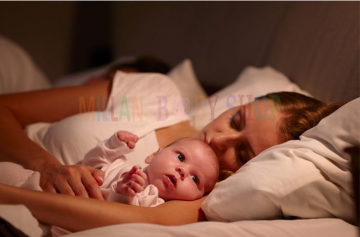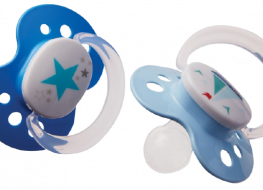
o-Sleeping, Bed-Sharing, And Room-Sharing — What’s Best For Baby?Are you having separation anxiety at the thought of your baby being out of your sight? Are you worried about that dangers that could befall your bundle of joy during sleep?Many moms feel unsettled or downright panicky at the thought of their baby sleeping in a different room from them. That’s only natural — your baby has slept with you for the past nine months. By now, it’s a habit.But before you decide upon your baby’s sleeping arrangements, you should take a closer look at the situation.What Are My Options For Sleeping?There are three ways of keeping your baby near you when you sleep:
- Co-sleeping.
- Bed-sharing.
- Room-sharing.
Some parents use these terms interchangeably, but co-sleeping, room-sharing, and bed-sharing are actually three different things.Let’s look at the difference between each of these methods and examine why some methods are better than others.
1. Bed-Sharing
Bed-sharing is when your baby sleeps in your bed with you. It can be appealing to parents who can’t bear the thought of being away from their baby.This is a hotly-debated topic amongst parents and experts who recognize the importance of a strong family bond. While some parents may love the idea of sharing their beds with their babies, experts are less than enthused — and with good reason.Bed-sharing is a huge risk for SIDS and other SUIDs, like suffocation.According to a few studies, bed-sharing is one of the riskiest behaviours a parent can participate in, particularly if they have been drinking at all. It’s far too easy to roll over on a baby and cause suffocation — and if you’ve been drinking heavily, you won’t even realize it’s happening.There are many reasons parents opt to bed-share, including:
- Not wanting to leave their baby alone.
- Feeling worried about things like SIDS.
- For some babies, it’s the only way they sleep well.
- For financial considerations when parents can’t afford cribs.
The Hazards of Bed-SharingHere are a few of the things that make bed-sharing so dangerous for young babies — some of these factors play a part in SUIDs.
- The height of the bed, coupled with the lack of railings, makes falling a real possibility, which can be catastrophic for a young baby.
- Many adults prefer a softer mattress, certainly softer than what baby cribs use. Those softer mattresses can cause a baby to sink in and pose a larger suffocation hazard.
- Most adults generally like to sleep with blankets, and those blankets can easily unknowingly be pulled up over your baby’s head. That can lead to suffocation quickly.
If you’re going to attempt to bed-share despite the warnings about how risky it is from professionals, there are a few tips you should follow to help your child avoid becoming a statistic.There’s no guarantee your child will be safe if you follow these tips, but they do offer a good starting point.
- Either Do It Or Don’t: You need to pick a side and stick with it. If you only bed-share sometimes, you might forget in the middle of the night that your baby is in there. You could roll over onto your baby and not even realize it.
- Don’t Bed-Share If You’ve Been Drinking Or You’ve Been Taking Drugs: It’s too risky for your baby. Anytime you’ve had alcohol, your baby should sleep elsewhere.
- Stay Away If You’re A Heavy Sleeper: If you’re a heavy sleeper, you shouldn’t bed-share. You’ll be less likely to notice any problems that are occurring. It’s far too dangerous for your baby.
- Dress Warmly: Wear a shirt that will keep you toasty so you don’t have to pull the blankets up any higher than your waist. That will cut back on the suffocation risk for your baby.
- Move Your Bed Away From The Wall: While that may make you nervous because of the risk of your baby falling from the bed, it’s easy for a baby to suffocate because they get trapped between the wall and the bed.
- Ditch The Water Bed: If you’ve been hanging onto the 1970s trend of a water bed, never bed-share. It’s way too dangerous for a baby because it’s not firm enough.
2. Co-Sleeping
Co-sleeping is when you sleep in your bed and your baby sleeps in a bassinet or crib that attaches to your bed. Think of it as a sidecar for your bed.While the rest of the crib or bassinet has full sides to it, the side that is next to your bed is lowered or off altogether. That allows you to touch or see your baby in the night without having to get out of bed to do so.Co-sleeping isn’t a great solution for everyone, but there are some moms who truly benefit from it.Here are some of the reasons you might want to consider co-sleeping.
- You want your baby right next to you, but aren’t comfortable with the idea of bed-sharing.
- You’re breastfeeding your baby and want to be able to do so in the middle of the night with as little disturbance as possible for everyone involved.
- You have a fussy sleeper on your hands and being next to them seems to soothe your baby.
- You’re worried about the possibility of SIDS and recognize that room-sharing methods like co-sleeping reduces that risk.
- You have less anxiety when your baby is in sight.
- You love to wake up next to your baby in the morning — having that cute little face be the first thing you see is a great feeling.
If you decide to go with co-sleeping, you may be worried you’ll have to buy two cribs — one for co-sleeping and another as your baby gets older and needs a permanent crib. But there are cribs that will work both for co-sleeping and as independent sleeping areas.Because co-sleeping products are still a fairly new market though, there aren’t a lot of products to choose from yet.Any co-sleepers will have to follow all the safety requirements that other beds also have to meet.Safety CheckIf you opt for a co-sleeper that has a lowered side, you’ll need to make sure it rests firmly against your mattress so there is no room for your baby to fall out.
3. Room-Sharing
If you’re looking for the least riskiest way to share sleeping space with your baby, you’ll want to consider room-sharing. Room-sharing comes with a host of benefits for babies and parents.It can:
- Ease a parent’s anxiety.
- Save them money because they won’t have to buy a baby monitor.
- It greatly reduces the risk of a baby dying in their sleep.
- It makes breastfeeding more convenient for both moms and babies.
- It may help a parent and baby sleep better.
- It doesn’t carry as much risk with it as bed-sharing and is more time-tested as a method than co-sleeping is.
But room-sharing isn’t for everyone. And while some parents find they sleep better with their babies in the room, others don’t fare as well. If you’re an extremely light sleeper, you might find that room-sharing, co-sleeping, or bed-sharing is too distracting to your sleep.Babies make a surprising number of noises when they sleep, and every one of those sounds might be enough to disrupt your sleep and potentially theirs if you feel the need to check on them in their crib with every noise you hear.The Bottom LineIt’s natural for you to not want to take your eyes off your baby. Your number one duty is to protect them and that’s easier to do when you’re in the same room.But there is such as thing as holding someone too tightly. And that applies in the case of bed-sharing. That should be avoided until your baby is older for safety concerns.Your best option is to co sleep by using a special crib that can be placed right next to your bed. Another good alternative is to keep a crib in your room, even if it isn’t right next to your bed.What kind of sleeping arrangements did you do with your baby? Please leave a comment and don’t forget to share this article with any pregnant women you know.



